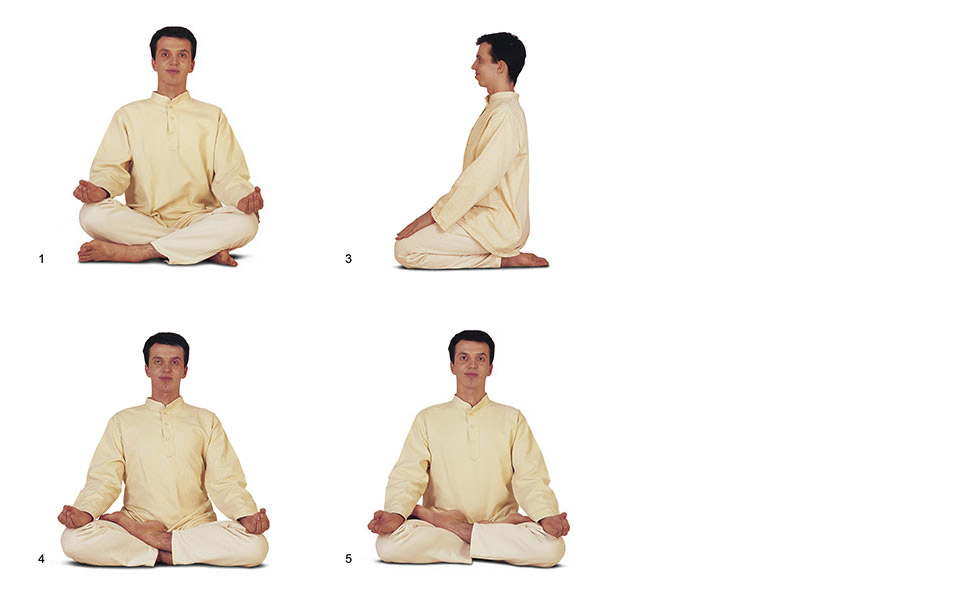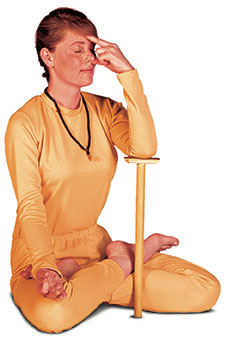
In Yoga there are five classical sitting positions:
-
Sukhasana - Comfortable Pose (cross-legged)
-
Siddhasana - Pose of the Adept
-
Vajrasana - Sitting on the Heels
-
Ardha Padmasana - Half-Lotus
-
Padmasana - Lotus
With all suitable sitting positions for Meditation and Pranayama, it is necessary to make sure that:
-
the upper body is straight and erect
-
head, neck and back are in alignment
-
shoulder and abdominal muscles are relaxed
-
the hands rest on the knees
-
the eyes are closed
-
the body remains motionless during the practice
Sukhasana - Comfortable Pose
This sitting posture is recommended for those who have difficulty sitting for a long period of time in Siddhasana, Vajrasana or Padmasana.
Practice:
Sit with the legs straight. Bend both legs and place the right foot under the left thigh and the left foot under, or in front of, the right calf on the floor. If it is more comfortable cross the legs in the opposite way. If it is difficult to keep the body upright then sit on a cushion at an appropriate height to make the posture comfortable.
If it is not possible to sit comfortably and painlessly in Sukhasana, practice the breathing and meditation exercises sitting on a chair. The most important point for everyone is that the upper body is straight, the body is relaxed and can remain motionless during the whole exercise.
Siddhasana - Pose of the Adept
Siddhasana quietens the mind, has a balancing effect on the Nadis (nerves) and activates the spiritual energy of the Chakras. Therefore, this sitting posture is well suited to the practice of Pranayama and Meditation.
Practice:
Sit with the legs straight. Bend the right leg and place the foot very close to the body on the floor. Now bend the left leg and place the left foot on top of the right calf. The sole of the foot touches the right thigh. Pull the toes of the right foot up between the thigh and the calf of the left leg and the toes of the left foot down between the thigh and the calf of the right leg. If it is difficult to keep the body upright or the knees do not rest on the floor, then sit on a cushion, at the appropriate height.
It is possible to practice this position bending the left leg first and bringing the right foot along the left calf.
Vajrasana - Sitting on the Heels
Vajrasana calms and harmonises body and mind. This position also stimulates digestion therefore it is recommended to sit in Vajrasana for about 5-10 minutes after a meal.
Practice:
Come up onto the knees (knee stand). The legs are together. The big toes touch each other, the heels point slightly outwards. Tilt the upper body forward and then sit back between the heels. The trunk is upright. Place the hands on the thighs.
Ardha Padmasana - Half Lotus
This posture is recommended for those unable to sit comfortably in Padmasana.
Practice:
Sit with the legs straight. Bend the right leg and place the foot very close to the body on the floor. Now bend the left leg and bring the foot very close to the body on top of the right thigh. The upper body is straight. Both knees should rest on the floor. If unable to keep the body upright, or bring the knees to the floor, sit on a cushion of an appropriate height.
This posture may also be practiced by bending the left leg first and bringing the right foot up on top of the left thigh.
Padmasana - Lotus
Padmasana, together with Shirshasana (Headstand), is referred to as the supreme or “royal” Asana. The Lotus posture activates and balances the Chakras and quietens the thoughts. It is an ideal sitting posture for Pranayama and Meditation.
Practice:
Sit with legs straight on the floor. Bend the right leg and place the foot very close to the body on top of the left thigh. Now bend the left leg and bring the foot very close to the body on top of the right thigh. The upper body should be completely straight and knees should touch the floor. To keep the trunk upright more easily and help the knees to rest on the floor, sit on a cushion of an appropriate height.
This position can also be practiced by bending the left leg first and then the right leg.
Position of the Hands
Particular Mudras are used with the breathing and concentration exercises and also for meditation. A Mudra is a position or gesture that is practised for a specific purpose or expression.
Chin Mudra - Position of the Fingers in Meditation
Practice:
In the meditation posture, place the hands on the knees with palms facing up. Thumb and index finger touch each other and the other three fingers remain straight but relaxed.
Chin Mudra represents the union of the cosmic with the individual consciousness. The index finger represents individual consciousness and the thumb, cosmic consciousness. The three remaining fingers symbolise the three Gunas, the three fundamental qualities of the world [1]. It is the goal of the Yogi to move beyond the three Gunas and to unite with the cosmic Self.
Pranayama Mudra - Position of the Hands in the Breath Exercises
Practice:
Place the index finger and middle finger of the right hand at the eyebrow centre in the middle of the forehead. The thumb is used to close the right nostril and the ring finger to close the left nostril.
If the right arm becomes tired it is also possible to practice with the left arm.
With longer practising of Pranayama, it is recommended to use a Pranayama rod (Yoga Danda).
